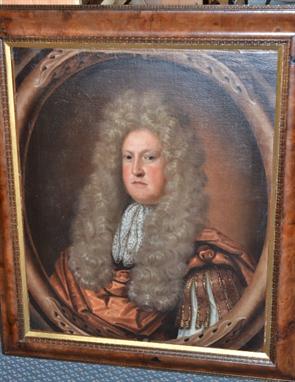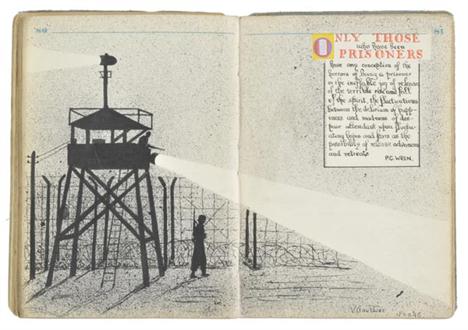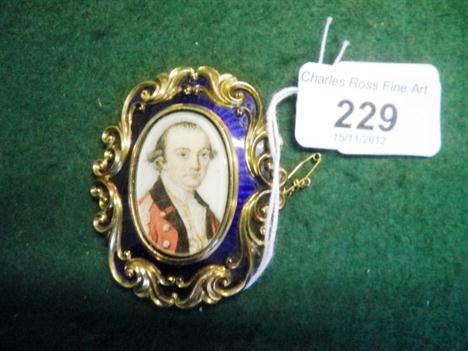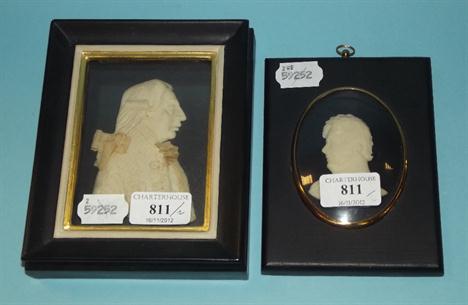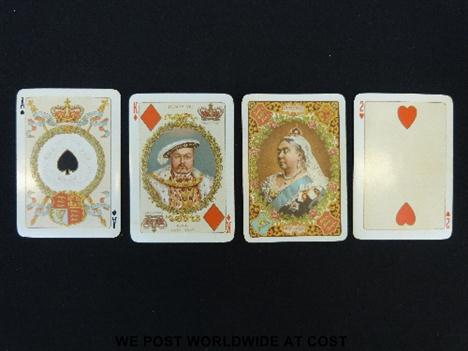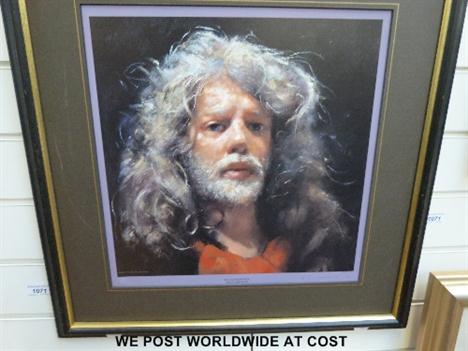Royal Interest: A Locket Pendant/Brooch, depicting a shoulder length portrait of Queen Victoria in high relief, within a border of alternating scroll sections enamelled in blue with pearl details, and old cut diamonds in pointed yellow settings, a pearl suspended from the base held in a diamond set and blue enamelled cup, with locket back which opens to reveal an enclosed lock of hair, and an inscription `Lady Victoria Alberta Leveson From Her Godmother Victoria R 1867`, measures 3.5cm by 5.8cm NB the pearls have not been tested Provenance: From the estate of Dr Helen Scott OBE
283284 Preisdatenbank Los(e) gefunden, die Ihrer Suche entsprechen
283284 Lose gefunden, die zu Ihrer Suche passen. Abonnieren Sie die Preisdatenbank, um sofortigen Zugriff auf alle Dienstleistungen der Preisdatenbank zu haben.
Preisdatenbank abonnieren- Liste
- Galerie
-
283284 Los(e)/Seite
A Cased Set of Twenty-Five Lava Cameo Buttons, each with a portrait of a male or a female character, the case with enclosures holding button backs, case inner marked `LONDON & RYDER 17, NEW BOND ST`, and three smaller buttons and three smaller dress studs, similar NB one button missing from the fitted case
Sir Thomas Lawrence RA (1769-1830) Portrait of Miss Croft, Aunt of Herbert Ryder; Portrait of a young man Both inscribed verso, pencil and light coloured wash, 21.5cm by 16cm and 22.5cm by 19cm respectively (2) Provenance: Paul Lemaire and Colnaghi, Pall Mall East, London; and Hibbert Brothers, Norfolk Art Galleries, Norfolk Street, Sheffield
Circle of John Riley (1646-1691) Portrait of ``Francis Russell, Son of the Hon. Edwd Russell``, half length, wearing period costume and armour with a powdered wig Inscribed, oil on canvas, oval, 63cm by 51.5cm Francis Russell was Governor of Barbados An attribution to John Greenhill has previously been suggested. See illustration
Vernon de Beauvoir Ward (1905-1985) ``Portrait of a Lady``, after the painting by Lord Leighton Signed and dated 1942, inscribed verso, oil on canvas board, 17.5cm by 14cm Born in Hampstead, the son of artist Albert Ward. Studied art at the Slade School. Elected an associate of the Royal Society of British Artist in 1926 and exhibited at the Royal Society and the Royal Institute of Oil Painters.
Aviation Ephemera. Aviation Ephemera. A Wartime Log for British Prisoners, Gift from the War Prisoners` Aid of the Y.M.C.A., compiled by Ronald Ernest Mellor, P.O.W. No. 172. Stalag Luft 3: Stalag Luft 6: Stalag 357: Stalag 355, c. 1945, 114 pp.(some pages unused), contains sketch map of six journeys made by p.o.w.s from one camp to another between 17 April 1942 and 8 August 1944, plus eight accomplished pencil cartoons satirising prison life, a pen and ink self-portrait caricature, a pencil drawing of `Tank Buster Ju.87`, by G. Crawford, Stalag 367 another of a Messerschmidt 110, by D.C. Buck, 19-8-44, a dramatic double-page pen and ink drawing of the guards tower at night time with searchlights on, signed `V. Gauthier, Feb `45`, four pen and ink ground plans of the p.o.w. camps, extensive handwritten details of the conditions within the camps, etc., orig. cloth bindings, rubbed and soiled, backstrip deficient, 8vo, together with Pilot`s Flying Log Book for Flight Officer J.C. Chesters, DFM, commencing 28.1.38 through to September 1944, final page of entries stamped in red `Death Presumed, Central Depository, Royal Air Force, June 1946`, orig. cloth, minor wear, 8vo, plus Handbook for the Installation, Running and Maintenance of Rolls-Royce `Merlin` Aero Engines Series II, May 1938 (revised and reprinted June 1941), numerous diags., some folding, orig. printed cloth, a little soiled, minor wear, 4to, and other miscellaneous printed aviation ephemera including logbooks, handbooks, aviation charts (a carton)
*Luftwaffe WWII. An interesting and varied collection of photographs, many unpublished, some from the Kruger collection, many of aircraft and personnel of the newly formed Luftwaffe, c. 1933-39, pilots, ground crews, aircraft portraits, the Heinkel He.111 in formation, interior cockpit details, experimental jet types, float and sea-planes, specialised armament, the Me109 in production, various civil types, Fw.200 `Condor` D-ACON, a portrait of Ernst Heinkel and many others of similar interest, approx. 150 images contained in a folder, some in sepia faded (approx. 150)
*Pioneer Aviation - Georges Guynemer. A cased bronze medal in celebration of France`s leading Air Ace of WWI, c. 1917, raised-relief with portrait image frontis inscribed `Capitaine Pilot Guynemer` and with further inscription verso `L`Escadrille 3` and Flying-Stork motif surmounting `Killed in the Field of honour after 3 years of Battle` 16th October 1917, in original presentation case, together with another cased bronze-relief medallion inscribed `Aviation - GF 1919` depicting Bleriot monoplane and figural imagery (2)
Sargeaunt (B.E.). The Royal Monmouthshire Militia. Being a Detailed Description of the Regiment from the Year 1660 to the Time of its Transfer to the Special Reserve, 2 vols, 1st ed., 1910-69, small piece missing from half-title of vol. 1, num. b & w illusts. from photos., matching recent half morocco gilt, thick 4to, together with Dulwich College War Record, 1914-1919, sepia photo frontis., numerous b & w photo portrait illusts., some light spotting towards rear of vol., t.e.g., orig. gilt-dec. blue cloth in bright condition, 8vo, plus Petre (F. Loraine, Ewart & Lowther, Cecil), The Scots Guards in the Great War 1914-1918, 1st ed., 1925, b & w plts. and maps etc., a few leaves with some spotting and staining, orig. cloth, rubbed and partly faded, author`s signed presentation copy to title to Dame Margaret Greville from Cecil Lowther, 8vo, and Mann (Michael), The Regimental History of 1st the Queen`s Dragoon Guards, 1st ed., 1993, numerous b & w plts. and illusts., orig. dark blue cloth gilt, a little rubbed, large 8vo, plus six issues of The Black Badge, The Journal of the Gloucestershire Regiment, Winter 1951-Winter 1953, including duplicate for Summer 1952 (11)
*Chard (Major John Rouse Marriott VC, 1847-1897). The Hero of Rorke`s Drift, a rare original Woodberry Gravure print depicting Major Chard and his medal award, the oval central image with vignette border on impressed mount, head & shoulders portrait, the subject with medal at left breast, inscribed `Major Chard, Lock & Whitfield - Woodberry Process` to lower mount frontis; mounted in contemporary moulded & gilded gesso frame with printed obituary notice captioned verso, detailing the events at the siege of Rorke`s drift with Lt. Bromhead, Gazetted 2nd May 1879 VC and promoted Captain & Brevet Major etc., 13 x 10in (33 x 25.5cm) (1)
* A group of items belonging to Group Captain H.R. Reid, D.F.C., M.I.D., Royal Air Force, Miniature dress awards, comprising, Distinguished Flying Cross, G.VI.R. General Service 1918-62, one clasp, Kurdistan India General Service 1908-35, G.V.R., one clasp, N.W. Frontier 1935 India General Service 1936-39, one clasp, North West Frontier 1936-37 Defence and War Medals with M.I.D. oakleaf, mounted for wearing, a fine black and white portrait photograph of the recipient in uniform wearing his full size medals, 30cm x 22cm, in a carved acanthus gilt-wood frame, 46cm x 34cm overall, Edmond. C.J., Kurds Turks and Arabs, Politics, Travel and Research in North-Eastern Iraq 1919-1925 hard back, published 1957 Maxwell, Donald., A Dweller in Mesopotamia, hard back, published 1921, inscribed to the recipient from his wife Margaret dated 28.7.1921, approx. 450 letters to his wife dating from 1920s onwards, five brass buttons each engraved with a heraldic lion by Pitt & Co, London and three albums of family photographs mainly post WW2 DFC, London Gazette 11.6.1924 `For services in Kurdistan 19th February to 19th June 1923`. Group Captain Harry Redvers Mclaren Reid, born Newtyle, Forfar, Scotland 23.12.1899, educated at Harrow, joined the Royal Naval Air Service as Flight Officer 10.3.1918, excelled as a flying instructor, joined No.6 Squadron in Iraq 31.1.1922, moving to No.208 Squadron from 27.12.1924, it was with this Squadron that he was awarded the D.F.C. for bombing operations against the Kurds and Turks, this is recorded in Edmonds. J.C., Kurds Turks and Arabs (p299/300) `We started the intense bombing of Marga today, I went up to point out the targets. My pilot, McLaren-Reid, did some beautiful shooting; one `copper` in particular burst in the doorway of the serai and ought to have done some damage. The sensation of bombing is exhilarating as you cruise over your target and each discharge heel over to look down on your handiwork before working round to repeat the attack. One does not get the feeling of any great speed oneself, but the other machines look like so many angry hornets and terribly businesslike`, served in Aden June-October 1925 in an Army Co-operation role bombing recalcitrant sheiks and it was during this period that he met his wife Margaret and subsequently married her in 1927. He had a keen interest in animals and kept lion-cubs, foxes and owls, he was posted to R.A.F. Cranwell from 1.2.1926 and trained R.A.F. officer cadets, served in No.22 (Bomber) Squadron, and was involved with testing Schneider Trophy aircrafts at Farnborough, served in India from 7.2.1933,-18.4.1937, moved to South America and served as Air Attache from 16.7.1941, the remaining war years were spent at Farnborough, Egypt and Italy.()
*An outstanding Second World War 1942 Immediate `Malta` D.F.C. to Spitfire Ace Flight Lieutenant N.C. Macqueen, Royal Air Force who in his short career was credited for 7 confirmed Victories and scores of probable downed enemy aircraft, Killed in Action only a few days after winning his award, Distinguished Flying Cross, G.VI.R., reverse officially dated `1942`, extremely fine, in Royal Mint case of issue, together with Pilots logbook kept by Flight Lieutenant N.C. Macqueen, first entry reads My Original Log Book:- Lost in a Submarine in Transit to Malta, record of previous service from June 1940 to February 1942, served with 610 & 602 Squadron (Spitfire) summary of service during this period 15.12.1941 - 15.1.1942, stationed at Prestwick, Ayr, Kenley and Redhill (Spitfire) `In the Kenley Wing, I took part in 48 sweeps over France. Victories :- One probable & one damaged ME.109 (F), I got shot up once, Operational Hours 102; 10.2.1942 `I left Liverpool in the S.S. Cape Hawke, escorted by two corvettes, en route for Gibraltar. We had aboard our fifteen Spitfire V B`s tropicalized & with 90 gallon Long Range tank. These were the first Operational Spitfires to go overseas`, grand total Operational Hours 190, 340.30 hours on Spits; Operation Spotter., 7.3.1942 with 249 Squadron stationed at Takali, Malta, H.M. Aircraft Carrier `Eagle` at a point about 30 miles North of Algiers to Malta `We were, I believe the first spits even to take off from an Aircraft carrier. We were led by a Blenheim which went about 130 mph, & which I over-shot and lost about 300 miles from here. But I managed to arrive ok with almost 50 gallons left`; 10.3.1942 `4 Spits & 11 hurries airborne against 18 Ju88`s & 26 ME109s I damaged one Ju, Ken Murray was lost`, various scrambles and long range shooting between this period; 14.3.1942 `4 Spits ordered to attack ME109`s (15) in the vicinity of a German rescue boat. I saw 3 about 10000 ft below & dived to attack. Used all my ammo & got one; 18.3.1942 `Fox lost - shot down by Lt. Kurt Lavinger, who I shot down North of St Pauls Bay: Confirmed :- (there is an entry in the logbook by Kurt); 22.3.1942 `Escort to seven Albacores:- 2 ME109`s attacked & I shot one into the sea`, 5 minutes later `in heavy cloud 2 Spits did a standing patrol all day over grand harbour, during which attacks were made by 70 Ju88 & 30 ME109s, Bob & I set both engines of one Ju88 on fire; 4.4.1942 Scramble (Most Freighting) `4 Spits & 6 Hurries v 50 plus Ju88`S, 87`s & ME109`s, chased an 88 out to sea & fired all my ammo, then I got jumped by 5 ME109`s and my engine packed up, it came on again at 200ft, after I`d tried to bail out, but the hood had jammed. Got rid of the 109`s & returned with machine unscathed`, on the same day `4 Spits & 12 Ju88`s & 15 ME109`s, got a Ju88 , it crashed into the sea in flames - no one bailed out`; 14.4.1942 `With Bob I was cover for Maryland - masses of 109`s about, we got one & damaged one between us, & I damaged another; 20.4.1942 `Awarded D.F.C. April 19th ` `6 Spits v 130 plus:- Got attacked by 6 ME109`s, got away & later got a Ju88 confirmed`; `21.4.1942 `As usual masses of huns:- things getting a trifle hot` entry on the same day `Shot an ME109 into the sea off Fifla & later damaged a Ju88, 4 Spits v 80 plus huns, their cover for the bombers getting very good`; 24.4.1942 `Even more ME109`s than ever. Got chased about for 25 mins with no ammo, & then almost got shot up landing with no petrol; 1.5.1942 `Took off with P/O Watts & Paul - who disappeared to test his cannons. Watt`s & I had a short burst & then ran into 4 ME109`s with over-load tanks, which they jettisoned, we milled about & had a lot of fun, before they departed` The final entry in the log book is on the 4th May 1942 written by Squadron Leader Bluant O.C. 249 Squadron `Scramble 17.45hrs, Killed in action - shot down by an ME109, Victories, Enemy aircraft destroyed 7, enemy aircraft probably destroyed 1/2, enemy aircraft damaged 6`, the following page has two red stamps `Killed in Action` and `Central Depositary Apr 1946 Royal Air Force` A fine b&w portrait photograph of Macqueen proudly sporting his D.F.C. riband, most probably the last photograph taken of him, 23.5cm x 18.3cm Eight R.A.F. Edition (War) Navigators charts for The United Kingdom, inscribed with names of colleagues serving with Macqueen in 249 Squadron Davis (Peter). Tattered Battlements, A Malta Diary by A Fighter Pilot, 2nd ed 1943, hbb, 133pp, 17 b&w illustrations, this an account of the Battle of Malta and records Macqueen on the several occasions, with inscription to `Ian Gordon Macqueen, Worcester College, Oxford, August 43` D.F.C. London Gazette 1.5.1942 Acting Flight Lieutenant Norman Carter Macqueen (866689), Royal Air Force Volunteer Reserve, No. 249 Squadron `This officer carried out a large number of sorties over enemy-occupied territory and destroyed I` [sic] enemy aircraft whilst based in this country. In the Middle East he has destroyed 4 hostile aircraft. Throughout his operational career Flight Lieutenant Macqueen has rendered most valuable service. He has displayed great skill and leadership.` Flight Lieutenant Norman Carter Macqueen DFC, RAFVR (1920-42), born in Leamore, West Midlands, educated at Fettes College, Edinburgh (1933-38), joined the Royal Air Force as Aircraftsman 2nd Class (Rhyl 1939), various promotions, Commissioned Pilot Officer 12.11.1940, served with 610, 602 and 249 (Gold Coast) Squadron, stationed at Ta Kali, Malta as part of Operation Spotter, in his very short career Macqueen was credited as one of the Malta Fighter aces with 7 confirmed enemy aircrafts downed and scores of assisted and damaged. Macqueen was killed in action on 4th May 1942 when his Spitfire nosedived, an account in the Malta War Diary records `RAF fighter pilots at Ta Qali had to watch helplessly as one of their comrades was jumped by a German fighter this afternoon. Flight Lieutenant Norman Macqueen was one of eight Spitfire pilots scrambled to intercept a heavily protected formation of Italian bombers attacking Grand Harbour. He was heading back towards Ta Qali from where his comrades watched as he was jumped by a Messerschmitt fighter `Norman was flying with another Spitfire and about to attack some 109s, when we saw a 109 sweep across the sky behind him. Vainly we shouted, `Turn! Spit!` as if there was some hope that he might hear us. But evidently neither of them saw the 109 and just kept straight on. We saw the 109`s tracer going right into Norman`s machine. His spitfire lurched and gave up a thin smoke trail. For some time it seemed to be under control and circled downwards as if he hoped to land. Then suddenly the nose went forward, and the machine dived like a stone into the ground, bursting into flames as it hit`, Macqueen is buried in Kalkara Cemetery, Malta. Provenance: Sold on behalf of the family. (-)
*Medals and photographs relating to Sapper F.W. Thomas I.S.M., Royal Engineers, comprising British War and Victory Medals (797 Spr. F.W. Thomas. R.E.), Imperial Service Medal, G.VI.R. (Francis William Thomas), extremely fine, with named box of issue and silver medal inscribed to the recipient for Services Rendered by the town of Crickhowell, a Suez Canal Zone pass dated 24.3.1918, several black and white portrait photographs of the recipient as a child, a soldier and with family, a black and white postcard written by the recipient to his son , titled `Trumpeter `Cheshire Darkie` Cheshire Field Coy R.E.s Mascot` dated 8.3.1918, and a huge archive of snap shot black photographs taken by the recipient during service in Egypt mostly captioned in ink on the reverse, many topographical, colleagues and friends, Turkish prisoners of war, executions of Armenians and enemy bi-planes (-)
*Flying Officer C. McLaren-Reid, Royal Air Force, Boei Glodak P.O.W. Camp, Java 1942-45, A rectangular teak table top inscribed with the names of all the R.A.F. Officers and Warrant Officers at the time of imprisonment in Boei Glodok, 1942-45, the top left with characters for the Japanese equivalent of McLaren-Reid`s initials, with central design of the solitary confinement cells, within chain border and bottom link inlaid with signed silver plaque of Mountbatten of Burma, 50cm x 85cm, together with an number of original documents relating to the table top, including, Letter from Buckingham Palace dated September 1945, welcoming Reid home, a letter confirming release of the table from Customs 1946, Caxton Exercise Book with names and addresses of the names on the table top, an archive of letters from fellow prisoners and their families, photographs Japanese Prisoners in Batavia formerly connected with Allied Prisoners-of-War, portrait photograph of Reid in uniform and one Reid and the table top, newspaper cuttings detailing the story of the table top, documents discussing the table top being exhibited at The Scottish United Services Museum in 1949 R.A.F. section at the Edinburgh Castle, exhibited with other P.O.W. work from the Napoleonic Wars. The Clarion magazine published 1949, detailing the story of the table top, also included in the lot is a heavy silver cigarette case engraved with heraldic crest and motto `Nihil Amanti Durum` (nothing is hard for one who loves), the reverse engraved with a record of service from January 1916 - February 1953, approx. 5.5 oz, Birmingham 1943, and three personal photograph albums, mainly post WW2. The Tale of a Table, Java 1942, The R.A.F. orderly room in Boei Glodak, the civil gaol in Batavia for long-term prisoners, in half of which some 1200 R.A.F. personnel were crowded, was a cell-like room in the administration block some twelve feet by six. The furniture consisted of one small table, a chair and a couple of empty boxes, and the table did duty for the C.O., myself and the clerk, as necessity demanded. After cajoling, threatening and imploring the officer in charge of the workshops for a month or more an extra table was made for myself. The table was made from old sleeping boards used by the civil prisoners in peace time, but found to be hopelessly bug-ridden as to be unusable by our men. The top was a single piece of teak, approximately thirty-four inches by twenty inches. As Adjuntant and interpreter, my time was more than fully occupied for the first three months, but after that things got easier, and I occasionally found myself with nothing to do, there being very few available. The then Japanese Commandant, a regular officer, had encouraged arts and crafts, and a successful exhibition had been held, many of the exhibits being made by expert hands. One day it crossed my mind to do something of the sort myself, and the idea of carving the names of the Officers and Warrant Officers on my table occurred to me. I found that I had more space than was needed, so included a view of the solitary confinement cells. I finished up by placing a symbolic chain round the outside, the links being copied from the chains used on the civilian prisoners. I managed to borrow an extremely blunt and jagged-edged gouge for a short while to remove the wood to give depth to the picture, but, apart from that, had only one blade of a `Dewars` advertisement penknife, a bone handled nail file and a sharpened nail or two to work with. It took nearly four months to complete and looked a pretty amateurish job when I had finished, but it kept me occupied and I was quite pleased with, not to say proud of it. In October, the night before our first draft left, I got everyone available to autograph the back of it, but one man would never be there to sign. He had been captured one night early in April with two Sergeants pilots while making a gallant and very nearly successful attempt to steal an aircraft from the local aerodrome, after they had escaped from the gaol and made their way through the town. We never saw them again. I put a coating of brown boot polish on the carving, made a three ply cover for it, and was looking for a place to hide it when, quite unexpectedly, in January 1943 the R.A.F. were moved to a camp at Tandjong Priok, the port for Batavia. Before leaving I handed it over to a Dutch friend, Lieut. G. Vischer, R.N.N.R. to hide for me. We stayed at Tanjong Priok only three months, and were moved to `Cycle Camp`, Batavia, an old Dutch army barracks. Here I met Lieut. Vischer again. His crowd had been moved suddenly from Boei Glodak the day after we left, so he had handed the table over to an Ambonese officer, who had been unable to hide it before he himself left and the gaol was closed. The gaol was re-opened for some months as a rope-spinning factory, and several hundred British personnel went there from `Cycle Camp`. The Adjutant found the table and looked after it, but, when the time came to leave, was too busy to hide it, so once again it was left lying about. Although they closed the gaol again the Japanese decided to keep on the vegetable gardens around the gaol, and for quite a while a party went there daily from `Camp Cycle`. The Dutch officer in charge of the party told me that he had been inside the gaol, and had seen the table stowed away in a furniture store. And that was the last I heard of it up to the time I left Java at the end of September, 1945. London 1946 One day in June my friend Dudley Grundy telephoned to my flat and said he had great news for me. He had just heard from `Wiggie`, Squadron Leader C.C. Wigram, that the table had been found. Wiggie had just arrived from India, where he had been recuperating after our release, and on the way home in H.M.T. `Cape Town Castle` had met a Wing Commander of the R.A.F. Regiment. It transpired that the latter had been in Java, particularly Batavia, and, while describing what had been going on there after the arrival of the British, mentioned that one of his raiding parties had found a bit of wood with a lot of names mentioned on it, and had taken charge of it. Wiggie recognised the description as that of my table top, and told the Wing Commander that he knew the owner and would pass on the information. As a result I got in touch with the Wing Commander, who told me that the carving was in safe hands, but he could not say where. At his suggestion I went to the Historical Records Section of the Air Ministry it was not there, but a lot of stuff was expected from Singapore, and I was assured that if it arrived I would be informed at once. I then wrote to the Officer in charge of the Historical Records Section in Singapore asking him to keep it, if he had it, as I was sailing for Malaya very shortly. I received no answer to this letter. When I reached Malaya I started my search again. After a number of letters had been written and answered I traced the table top to the R.A.F. Provost and Security Services in Singapore, in whose custody it was pending onward transmission to the War Museum. I then wrote to the Air Officer Commanding-in-Chief S.E.A. asking for the necessary authority for its release, and, on 8th December, 1946, saw it again after nearly four years. It was a bit knocked about. Several of the letters were chipped and vandals had seen fit to knock a few rusty nails into it, but the boot polish finish was still there. The autographs on the back had nearly all faded away, and did so completely when I oiled the wood. I finished off the carving by inserting the date of our release, and by splitting the bottom centre link of the chain, which, with justifiable optimism, I had made larger than the others, in preparation for the day when our bonds would be broken. (I did not explain this to the Japanese who saw the table!)Now there was one thing left to do. There was space inside the broken link for an autograph, and there was one person only whose name I wanted there. I intended sending the carving itself to England, but it was bulky, and would be inconvenient; in addition to which it would take months to get there and back. Instead of this I took the spoon and fork which I had used throughout my prisoner-of-war time, which constituted the last of the `Family silver`, the remainder having been looted from my house in Malaya, to a local silver-smith, who made a flat plate out of them. This I posted home by air mail, and, in a few weeks, it was returned, autographed, together with a short but gracious letter. A coat of varnish to keep the silver from oxidising and into its place it went. Of those whose names are on the carving the majority are alive. I send them this card as a memento of hard times shared, and with my best wishes for the future. To the relatives of those who are gone, I offer it as my humble tribute to the memory of the dead.()
19th Century English School - Oil on canvas - Portrait of a young lady wearing a blue dress, 76.5cm x 63.25cm There are several tears - the largest of which is shaped like the number 7 and measures 10cm vertically and 7cm horizontally, another just below the lady`s neck which measures 5cm x 4cm, there are also various areas that have been `patched` and it is rath
Late 19th Century majolica circular plaque having relief decoration depicting a profile portrait of a Renaissance lady wearing a plumed hat, 38cm diameter There are two flakes to the glaze approx 6`oclock on the reeded inner border, the largest measuring approx 10mm x 4mm, here is a firing crack running the length of the lady`s collar at a point where it meets the brown glaze of her dress, there are some mi
TREDGOLD, Thomas: Peter Barlow, Elementary Principles of Carpentry; A Treatise on the Pressure and Equilibrium of Beams and Timber Frames, 4tp fifth and best edition, considerably enlarged. Pp 336, 64 plates, and a portrait of the author, bound in original brown blind stamped cloth with new matching spine with gilt titles and recased
Private collection of playing cards and gamesFamous Personages, William Darton 58 Holborn Hill, playing card game, 29/32, each showing a portrait with text below giving a short biography, circa 1820`sThis lot forms part of a private collection of playing cards and games from the 17th century onwards, comprising 400 lots, all to be sold without reserve
Private collection of playing cards and gamesCharles Goodall & Son playing cards, commemorating Queen Victoria`s Jubilee of 1897, the backs showing a portrait of Victoria, gilt edges, in original slip caseThis lot forms part of a private collection of playing cards and games from the 17th century onwards, comprising 400 lots, all to be sold without reserve
Private collection of playing cards and gamesA hand drawn pack of transformation playing cards, possibly De La Rue backs, ace of spades being a portrait of a woman within the spades symbol, circa 1870`sThis lot forms part of a private collection of playing cards and games from the 17th century onwards, comprising 400 lots, all to be sold without reserve
Private collection of playing cards and games`History of England` card game, each card with coloured portrait of mornarch and text below , numbered in ink to reverse 1-32 (only 26 cards in total, 6 missing) and also inscribed in ink `Shapland`, one inscribed to reverse `Miss Ann Parkinson her cards given to her by her ever affectionate boy.. Jereh Parkinson Anno Domini 1805`This lot forms part of a private collection of playing cards and games from the 17th century onwards, comprising 400 lots, all to be sold without reserve
Private collection of playing cards and games`History of England` card game, each card with hand coloured portrait, each having been numbered to reverse in ink, number 7 missing otherwise up to 32 (George II), some cards having name to reverse in ink, in remains of original card case, circa mid-late 18th century This lot forms part of a private collection of playing cards and games from the 17th century onwards, comprising 400 lots, all to be sold without reserve
A commemorative French pottery plate marked Sarreguemines. The central monochrome oval portrait of Alexandra Tsarine of Russia, surrounded by brown printed scenes (Alexandra married Nicholas II, Emperor of Russia, they were murdered in 1917. She was a Grandaughter of Queen Victoria). This rare plate is one of a pair recording a visit to France in 1896.
-
283284 Los(e)/Seite











